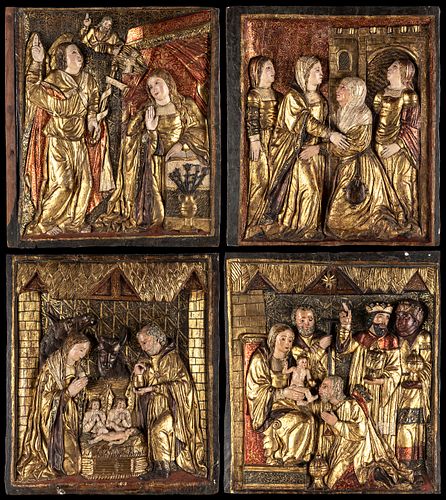Renaissance school, the first third of the sixteenth century. Master of the environment or workshop of FELIPE DE BIGARNY (Langres, France, 1475 - Tole
Lot 74
About Seller
Setdart Auction House
Carrer Aragó 346
Barcelona
Spain
Setdart Subastas was born in 2004 and is currently the first online art auction in Spain with solidity, prestige and reliability guaranteed by our more than 60,000 users. Setdart has a young, dynamic and enterprising team ready to successfully manage the purchase and sale of art works through custom...Read more
Estimate:
EUR€40,000 - EUR€50,000
$41,666.67 - $52,083.33
Absentee vs Live bid
Two ways to bid:
- Leave a max absentee bid and the platform will bid on your behalf up to your maximum bid during the live auction.
- Bid live during the auction and your bids will be submitted real-time to the auctioneer.
Bid Increments
| Price | Bid Increment |
|---|---|
| EUR€0 | EUR€10 |
| EUR€200 | EUR€25 |
| EUR€500 | EUR€50 |
| EUR€1,000 | EUR€100 |
| EUR€3,000 | EUR€200 |
| EUR€5,000 | EUR€500 |
| EUR€10,000 | EUR€1,000 |
| EUR€20,000 | EUR€2,000 |
| EUR€50,000 | EUR€5,000 |
About Auction
By Setdart Auction House
Oct 20, 2021
Set Reminder
2021-10-20 07:30:00
2021-10-20 07:30:00
America/New_York
Bidsquare
Bidsquare : OLD MASTERS
https://www.bidsquare.com/auctions/setdart-auction-house/old-masters-7700
Setdart Auction House sofia@setdart.com
Setdart Auction House sofia@setdart.com
- Lot Description
Renaissance school, the first third of the sixteenth century. Master of the environment or workshop of FELIPE DE BIGARNY (Langres, France, 1475 - Toledo, 1543). "The Annunciation", "The Visitation", "The Nativity" and "The Adoration of the Kings". Set of four important reliefs in carved, polychrome and gilded wood, which come from the same altarpiece. Measurements: 77 x 66 x 8 cm, 77 x 66 x 6 cm, 77 x 66 x 7 cm and 76.5 x 63.5 x 6 cm. Due to its physical and formal characteristics, the important group of four reliefs that we present fits within the remarkable sculptural focus developed in Burgos at the beginning of the 16th century, which had Felipe de Bigarny as one of its greatest exponents. We can highlight, among other aspects, the extraordinary state of conservation of the original polychromy, the gilding, the stew and the carving in general, which, over the years, has remained practically intact. Within the arrival of the new Renaissance doctrines in Spain, specific centers such as Aragon, Burgos or Granada stood out. Specifically, the Burgos focus counted with the presence of Diego de Siloé, who worked extensively in the cathedral of Burgos, elaborating the chapel of the Constables together with Felipe Bigarny, in the lateral altarpieces and in the Golden Staircase. His good work as a Renaissance sculptor was evident throughout the province of Burgos. From the artistic point of view, 16th century Spain underwent a process of transformation towards the new art of humanism implanted in Italy, much slower due to the need to learn the new techniques and, of course, to change the taste of the clientele. Sculpture reflects, perhaps better than other artistic fields, this eagerness to return to the classical Greco-Roman world. Anatomy, the movement of the figures, compositions with a sense of perspective and balance, the naturalistic play of the folds, the classical attitudes of the figures soon began to be valued; but the strong Gothic tradition maintains the expressiveness as a vehicle of the deep spiritualist sense that informs our best Renaissance sculptures. This strong and healthy tradition favors the continuity of religious sculpture in gilded and polychrome wood, which accepts the formal beauty offered by Italian Renaissance art. In the first years of the century, Italian works arrived in our lands and some of our sculptors went to Italy, where they learned first hand the new norms in the most progressive centers of Italian art, whether in Florence or Rome, and even in Naples. Upon their return, the best of them, such as Alonso Berruguete, Diego de Siloé and Bartolomé Ordóñez, revolutionized Spanish sculpture, even advancing the new mannerist, intellectualized and abstract derivation of the Italian Cinquecento, almost at the same time that it was produced in Italy. Felipe Bigarny, was a master sculptor and carver from Burgundy living in Spain, considered one of the most distinguished of the Spanish Renaissance. He also presented some projects as an architect. In his works coexist Flemish, Burgundian and Italian Renaissance features. He achieved great prestige and became the master of sculpture and carving of the Cathedral of Burgos. He also intervened in important works throughout the Crown of Castile, managing several workshops simultaneously, which gave him a good socioeconomic position.
- Shipping Info
-
In-house shipping available. Please inquire at admin@setdart.com.
-
- Buyer's Premium



 EUR
EUR CAD
CAD AUD
AUD GBP
GBP MXN
MXN HKD
HKD CNY
CNY MYR
MYR SEK
SEK SGD
SGD CHF
CHF THB
THB









